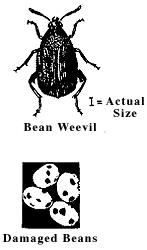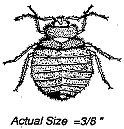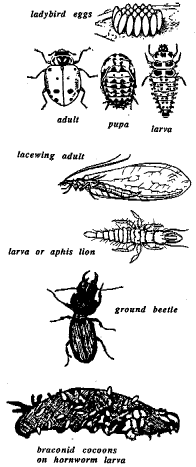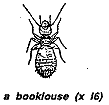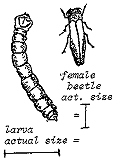|
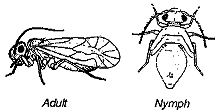
In late summer, usually about mid-August, very large clusters of brown, soft-bodied insects may be seen moving in masses on the bark of trees, especially maples, boxelder and willows. These insects are winged and about 1/4 inch in length.
These may be insects commonly called barklice, or psocids (pronounced so'sid). The adult psocids congregate on the tree trunks to feed on lichens growing on the bark. Lichens are composed of a fungus body enclosing a green or blue alga. The fungus receives some food from the alga, and the alga some food and protection from the fungus. This relationship is called symbiotic. The lichens depend on trees mostly for support.
Most of the life cycle of the psocids is spent on the ground among debris and plant litter where these insects feed on decaying organic matter. The barklice are really only a curiosity and present no problem other than a general nuisance because of their large numbers.
Since these insects do not cause any damage, no control is
necessary in most cases. Occasionally, if the insects become a great
nuisance, a yard type aerosol insecticide or malathion sprayed on
them will control them.
Back to Pest Information
|
Acanthoscelides obtectus (Say) |
|
|
INJURY: In the field, kidney beans, lima beans and cow peas are attacked. In storage all varieties of beans, peas, lentils and some seeds are attacked. The larvae feed inside the beans and when numerous, nothing but the shell remains. This reduces the food value of the beans as well as reducing the germination potential of the bean seed. DESCRIPTION: |
LIFE HISTORY:
Adult weevils lay eggs on the developing bean pods in the field. In 3 to 30 days the tiny grubs emerge and make their way into the seed. Here they feed until mature, and pupation occurs. When the adults are ready to emerge, they cut round holes (1/10 inch in diameter) through the seed coat and crawl out.
Indoors in stored seed multiple generations occur and breeding
continues as long as there is any food left in the beans and the
temperature is suitable for reproduction.
Back to Pest Information
|
|
|
|
In most parts of the United States the only bed bug of importance to man is Cimex lectularius. Bed bugs feed on blood, mostly from people in this species but are also known to feed on bats or other animals including rabbits, rats, guinea pigs and domestic fowl, especially when they are housed in laboratories. The bed bug has a sharp beak which it uses to pierce the skin of the host. It then begins feeding, injecting a fluid which helps in obtaining food. This fluid causes the skin to become swollen and itchy. Bed bugs are nocturnal, that is, they feed at night, often biting people who are asleep. Where infestations are severe one may detect an offensive odor which comes from an oily liquid the bugs emit. |
DESCRIPTION:
A mature bed bug is an oval-bodied insect, brown to red-brown in color, wingless and flattened top to bottom. Unfed bugs are 1/4 to 3/8 inch long and the upper surface of the body has a crinkled appearance. A bug which has recently fed is engorged with blood, dull red in color, and the body is elongated and swollen. Eggs are white and are about 1/32 inch long. Newly hatched bugs are nearly colorless.
LIFE CYCLE:
Bed bugs undergo a gradual metamorphosis (change in form) and
the young resemble the adults. The young are called nymphs. Under
ideal conditions (bugs feed regularly and temperatures are above 70
degrees F) eggs are deposited in batches of from 10 to 50 in crevices
of bed frames, floors, walls and similar household sites. When fresh,
the eggs are coated with a sticky substance which causes them to
adhere to any object on which they are deposited. Eggs are not
deposited at temperatures lower than 50 degrees F. Eggs hatch in 6 to
17 days but may take as long as 28 days in cooler temperatures. The
nymphs begin to feed as soon as they can locate a host. They molt 5
times before reaching maturity and the nymphal period lasts about 6
weeks. There may be up to three generations per year in our climate.
Bed bugs feed for a period of 3 to 5 minutes, after which they are engorged and drop off the host. They crawl into a hiding place and remain there for several days digesting the meal. When hungry again, they emerge from the hiding place and search for a host. If no food is available, the new nymphs may live for several weeks in warm weather, or several months in cool weather. Older bugs may go for 2 months or longer without food.
Where are bed bugs found? Hiding places can often be discovered by
keeping an eye out for black or brown spots of dried insect excrement
on surfaces on which the bed bugs rest. Eggs, eggshells and cast
skins may also be found in resting places. Early in an infestation
bed bugs are likely to be found only about the seams, tufts or folds
of mattresses or daybed covers, but later they spread to crevices in
the bedsteads. In severe infestation they may be found behind
baseboards, window and door casings, pictures and picture frames, in
furniture, loosened wallpaper, cracks in plaster and the like.
Back to Pest Information
|
|

There are many types of beetles known to the entomologist. In our area generally only a few are harmful to ornamental plants. Some of the more troublesome include:
ROSE CHAFER:
This insect is often referred to as the rose bug, but it is actually
a beetle. The adult is a tan-yellow color, about one-half inch long,
and has long spiny legs. The adults especially like to feed on roses,
peonies and grapes, but will also feed on many other plants - apple,
blackberry, cabbage, corn, geraniums, peach, Virginia creeper and
wisteria.
The beetles appear in large numbers in late May and early June. They first feed on flowers and then go to newly set fruit. There is only one generation per year, adults lasting three to four weeks. The eggs are laid in sandy soil and the larvae or grubs hatch in one to two weeks. The larvae feed on grass and seedling tree roots.
Hand picking will give temporary control. Any hand picked insects should be killed. The insecticides carbaryl (Sevin) or methoxychlor or rotenone may be used to control the rose chafer. Spraying should begin when the first chafers are seen (about May 25th). As many as four sprays at weekly intervals may be necessary to control the pest. However, let the effectiveness of your first spray be your guide.
JAPANESE BEETLE:
The Japanese beetle is about 1/4 inch long with the head and thorax a
shiny metallic green and the wing covers a coppery brown. The larvae, or grubs,
are also about one-half inch long, grayish white in color with three pairs of
legs on the forepart of the body. The grub lies curled in a letter "C" position.
The adult beetles feed on leaves, flowers or fruits of many kinds of plants including many ornamentals. The host list includes over 250 different plants. They eat the tissue between the veins of the leaves leaving only a skeleton of the leaf. The beetles are some-what social and prefer to feed in groups. The grub is a serious pest of turf, feeding on the grass roots. Injury usually shows up in May or June in sunny lawn areas as a thinning of grass. The grass may be partly or completely killed and the turf so loosened that it can be rolled up like a rug. The young grubs also feed in September and October.
Adult beetles deposit eggs during July and August. Eggs hatch in about 12 days into small grayish-white grubs which begin feeding immediately on the grass roots. The adult beetles emerge the following July and August at which time they feed on the foliage. After about 5 weeks of feeding, the adult beetles mate and the females return to the soil to lay eggs for the next generation.
Hand picking will provide some relief on small plantings. During July and August the beetles are effectively controlled with insecticide sprays also.
ORIENTAL BEETLE:
The Oriental beetle is a close relative of the Japanese beetle and
the Asiatic garden beetle. It is often called the Asiatic beetle
mistakenly because its life cycle and habits are similar. It is found
all along the eastern seaboard of the United States.
Adults are straw-colored beetles, about 1/2 inch in length, with dark markings. The adult beetle emerges from the soil throughout July and August when they may cause damage by feeding on grasses, ageratum, iris, hollyhock, phlox, rose, beans, rhubarb and strawberries plus many others.
Eggs are laid throughout July and August in the first few inches of soil, usually in grassy areas. The young larvae or grubs hatch in about 20 days and begin feeding on grass roots. There are no pesticides registered for use on this insect.
COMPANION PLANTING:
The idea that certain plants grown with other plants will discourage
insects and other pests, is one alternative to pesticides you may
wish to consider. The practice is said to be more effective in a
vegetable garden, but also can be a help in the flower garden. Using
plants in companion plantings does not guarantee control, it simply
puts plants the insects and other pests do not like, near the
preferred ones. These plants may have an odor or taste that is
objectionable to pest and may discourage its feeding on the preferred
plant. Geraniums and parsley planted next to roses are said to
discourage many beetle pests. (You may wish to add chives to
discourage aphids).
You should be aware, however, the substantiating data from
government experiment stations and colleges of agriculture concerning
the reliability and effectiveness of the companion planting idea is
generally lacking.
Back to Pest Information
|
|
INJURY:
Beetles of several species infest packages of whole grain and
grain products. The infestation may begin at the time of manufacture
or processing, in the warehouses of food distributors, in transit, on
the grocers' shelves, or in the home. Most food processors and
handlers make every effort to avoid insect infestations, but
occasionally the efforts fail.
Infestations are usually discovered when an infested package is opened for use, or when small brown beetles are found in the kitchen near containers of stored grain products. A wide variety of foods may be infested including flour, cereal, dried fruits, dehydrated vegetables, shelled nuts, chocolate, spices, candies, pet foods, and bird seed. Eggs, larvae, pupae and adults of the beetles may occur in the infested foods.
DESCRIPTION:
Two dozen or more different species of insects may occasionally infest grain and grain products used in the home, but four species are much more frequent than the others. Three of these are minute insects, and the fourth is of more moderate size.
The confused flour beetle is perhaps the most common. It is about 1/7 inch in length, an elongated dark brown hard-shelled beetle. Nearly as common is the saw-toothed grain beetle, which is slightly shorter and more slender. Both species lay eggs so small as to be nearly invisible to the naked eye. Their growth and development is similar. The newly hatched larva, a tiny cream-colored insect with dark head, feeds voraciously upon grain and meal, and under the best of conditions will complete its development in 6 to 7 weeks. The pupal stage will require another 10 days to 2 weeks, so that it is not uncommon to have 5 or more generations each year. Adult female beetles may lay hundreds of eggs during a two to three year life span.
A third species, the red flour beetle is a red brown color and slightly larger than the confused flour beetle. Its development is similar to those described above.
The yellow mealworm is a larger insect, the adult being more than 1/2 inch in length. It develops more slowly than the three small species, seldom completing a generation in four months and frequently requiring more than one year. Because these large black beetles are so easily seen and because of their extended period of development, infestations are usually discovered and treated before they become serious in the home.
Though these four are the most common of the beetles infesting
meal and flour in the home, many others are not uncommon and
vigilance is necessary to detect infestations as early as
possible.
Back to Pest Information
|
|
INJURY:
Furnishings and clothing made of wool, and of fur, feathers or hair,
are subject to damage by insects. The most serious insect pests of
such articles are beetles known collectively as carpet beetles.
Damage may range from the clipping of an occasional fiber, which only
slightly weakens the fabric and may go entirely unnoticed, to the
total destruction of articles left undisturbed for many months or
years. Fabrics made of a combination of wool with synthetic fibers
are not immune to damage.
Actual feeding upon wool fiber is done only by the beetle larvae, the presence of adult beetles is simply an indication of an infestation in the dwelling and that woolens should be inspected. The adult beetles themselves usually feed out of doors upon the pollen of flowers.
The feeding of carpet beetle larvae can be differentiated from the feeding of clothes moths by the fact that no tell-tale web is spun by the beetles. Where carpet beetle feeding is light, damage may therefore go unnoticed, or the fabric may ravel when only a single thread has been severed.
DESCRIPTION:
There are a few different kinds of carpet beetles that attack
woolens. The most frequently encountered carpet beetle in New York
State is the black carpet beetle, Attagenus megatoma. The adult
beetle is dull black in color, antennae and legs are brown, and it is
elliptical in outline, about _ inch long. The larva, on the other
hand, may grow to a length of _ inch before entering the pupal stage.
The larva is somewhat carrot-shaped, and bears a tail of long brown
hairs. Its body is covered with golden brown hair only slightly
lighter in color than the tail.
Two other species of carpet beetles are commonly found in homes in New York. They are the carpet beetle Anthrenus scrophulariae, sometimes called the common or old fashioned carpet beetle, and the furniture carpet beetle, Anthrenus flavipes. These two species are very difficult to tell apart, for their appearance and habits are quite similar. Both larvae and adults of these species are somewhat shorter and more robust in general appearance than the black carpet beetle. The larvae may be no more than _ inch long when full grown, and they are covered with rather long dark brown hairs. These features lead to the use of the term "buffalo moth" in referring to the larvae. Adults are less than _ inch in length, and present a mottled appearance due to scales of dull white, yellow, dark gray and reddish-brown color occurring in a diffuse pattern.
LIFE CYCLE AND HABITS:
In areas of the home where temperatures are held at a comfortably
warm level throughout the year, carpet beetles develop in an
uninterrupted cycle. When woolens are stored in an unheated portion
of the house, development slows or stops during the winter months,
the insects passing the colder season as larvae. In the spring, as
temperatures rise, the pupal stage occurs. The insects are inactive
during this period of transformation, which may last for 1 to 4
weeks. Then, adult beetles emerge, lay eggs on a fiber appropriate
for larval feeding, and seek the out-of-doors and flowers upon whose
pollen they feed.
Fifty eggs or more may be deposited by a single female. In 7-14
days the eggs hatch and the larvae begin their destructive feeding.
They avoid light during this period of growth, pausing on occasion to
shed their skins as they develop. Sixty days to nearly a year may be
spent in this destructive form, depending upon conditions of food and
temperature. The pupal stage again occurs, and with the emergence of
the adult, the life cycle is completed. Thus, as many as four
generations or as few as one may be passed in a year.
Back to Pest Information
|
|
|
|
LADYBIRD BEETLES OR
LADYBUGS: LACEWINGS: GROUND BEETLES: BRACONIDS AND OTHER
WASPS: |
These highly predaceous insects feed on a variety of other insects. They wait to ambush their prey with the front legs in an upraised position that gives them their name. The egg cases may be found on tree twigs and in fields, and for some fun, you may wish to watch them hatch in your own garden next spring. Egg cases may be gathered by cutting the twig you find them on, then tying the case to a branch in your garden. The young come tumbling out of their case by the hundreds in the spring. Praying mantids are cannibalistic and will eat one another. Only a few will survive under home garden conditions.
DRAGONFLIES:
These large insects may be seen soaring and darting about near
and over ponds and streams in a manner to arouse the envy of the most
daredevil aviator. They both catch and eat their insect prey while
flying. Mosquitoes and other flies make up a large part of their
diet.
SYRPHID FLIES:
Syrphid flies are commonly called flower flies -- they may be brightly
colored and many resemble wasps and bees hovering over flowers. However, they
do not sting. The larvae of most species are predaceous feeding on aphids or
the young of termites, ants or bees.
ANT LIONS:
The larvae, or doodlebugs, are queer looking creatures with
long sickle-shaped mouth parts. These insects are more commonly found
in the south or southwest, but there are a few species found locally.
The larvae hide in burrows in the ground waiting for an ant to
stumble into the burrow. Once inside, the ant is quickly consumed.
LIGHTNING BUGS:
During the early summer the adult insects fly about in the
evenings and are conspicuous by their blinking yellow light. Most of
the larvae are luminescent and are given the name "glowworms". The
larvae feed on various smaller insects and on snails.
Some predatory insects such as ladybird beetles and praying
mantids are available for sale. Ladybird beetles purchased in the
spring have likely been collected during their winter hibernation,
and upon release will soon fly away, often far from their release
site. If a home gardener buys predators feeling that his insect
problems will be solved by their action, he is likely to be
disappointed. It may be more useful to attempt to conserve the
natural predators already present in the area through the careful use
of insecticides and through the recognition of eggs and immature
stages of beneficial species. Ants that tend aphids, scales and
mealybugs should be removed since they disrupt the natural
enemies.
Back to Pest Information
|
|
|
|
INJURY: The most severe damage is caused by the grubs (larval stage) which feed on the roots and underground stems. They may girdle the root crown. Larvae even feed on roots of houseplants that spent the summer out of doors near infested plants. The symptoms are of general plant unthriftiness including stunting and yellowing or off-color foliage. Root feeding often results in death of the plant. Plants may fail to put out new growth in the spring as a result of the root injury or may put out the first flush of new growth, and subsequently die. Unfortunately, it is when plants are close to death that home gardeners often first notice the problem.
|
Adults may also be considered nuisance pests when found indoors, especially during the winter months. Some adults overwinter, seeking shelter near foundations and occasionally wander inside. Removing by hand when seen is the best control for a few individuals inside the home.
DESCRIPTION:
The adult is a black wingless weevil (snout beetle) about 3/8 inch
(10 mm) long. All of the weevils are females and they reproduce
parthenogenetically (reproduction by development of an unfertilized
egg). Since the weevils do not fly, they disperse chiefly by walking,
although they may be transported by man with infested plant material.
The weevils feed at night and hide under leaf litter or in the soil
during the day. When disturbed, the adults feign death.
The grub is a legless, white (with a brown head) larva with a wrinkled c-shaped appearance. It is found in the soil under host plants.
LIFE HISTORY:
There is one generation of the black vine weevil each year. Adults
usually emerge between mid-May and late July and live for several
months. A few adults may overwinter and be found in early spring.
Weevils feed for 3-4 weeks before females begin to deposit eggs. Eggs
are dropped indiscriminately to the ground under the plants (as many
as 500 per female!) over her entire life. If houseplants are placed
under shrubs during the summer, eggs may be deposited on the soil of
the containers. Ten to 14 days later the grubs hatch and burrow down
into the soil searching out roots to feed on.
Larval feeding occurs through the growing season and when colder
temperatures arrive, grubs burrow deeper in the ground to overwinter.
They resume feeding the following spring for a short while before
they enter the pupal stage. Pupation lasts about 1 month and adults
are most abundant from early June to mid-July.
Back to Pest Information
|
|
|
|
DESCRIPTION: INJURY: |
Any manufactured material of plant origin (furniture, paper, books, etc.) when stored in damp places, could support molds or mildew and encourage booklice infestations.
Booklice may become numerous during the spring and summer in homes, but may practically disappear during the winter. We may attribute this to the fact that artificial heat in houses reduces the dampness and therefore the fungi on which they feed.
LIFE HISTORY:
Booklice deposit white, oval shaped eggs near a food source. The
young, called nymphs, hatch from the eggs and begin feeding on molds.
They may undergo three or four molts while growing up. If ideal
conditions of temperature and moisture are met, the entire life cycle
may take as little as 25 days. Since ideal conditions do not exist
all year round, we usually do not see more than seven or eight
generations per year.
Back to Pest Information
|
Leptocoris trivittatus |
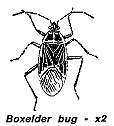 |
INJURY: DESCRIPTION: Eggs are a rusty red color and are not often seen as they are deposited in boxelder trees. The nymphs, also found on the trees, are bright red in color with the head end darker. Nymphs resemble adults but do not have fully developed wings and are not able to reproduce. The change from nymph to adult is a gradual one. |
The boxelder bugs pass the winter in the adult stage in dry, sheltered places where they have accumulated in gregarious masses. They often choose buildings or houses as a protected place to overwinter. When weather warms up in the spring, the bugs leave their places of hibernation to fly to boxelder trees where they deposit their eggs. Eggs are usually deposited in bark crevices and hatch in 11 to 14 days. The nymphs feed by inserting their beaks into leaves, fruits or soft seeds and sucking the plant juices. Feeding continues throughout the summer and the nymphs gradually mature becoming adults as cold weather approaches in the fall. In some areas there may be two broods of this insect, one reaching maturity in mid-summer and the second one in early fall.
Back to Pest Information
|
(Agrilus anxius) |
|
|
DESCRIPTION: INJURY: |
LIFE HISTORY:
Adults emerge in May and early June, depending on seasonable
temperatures. They feed for a time on the foliage of birches, aspens
and some willows. After feeding, the females lay eggs in groups under
loose flakes of bark or in cracks and crevices in bark or in areas
where recent injury has occurred. The young larvae bore into the
cambial layer and begin feeding and constructing galleries. This
insect overwinters as the larval stage under the bark and pupates the
following spring. The life cycle may be completed in 1 or 2
years.
Back to Pest Information

|
This site is developed and administered by Lake Technology Solutions, Inc. | www.LakeTS.com | (888) 332-8082 |
